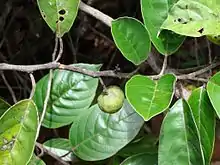| Emmotum | |
|---|---|
 | |
| Emmotum nitens | |
| Scientific classification | |
| Kingdom: | Plantae |
| Clade: | Tracheophytes |
| Clade: | Angiosperms |
| Clade: | Eudicots |
| Clade: | Asterids |
| Order: | Metteniusales |
| Family: | Metteniusaceae |
| Genus: | Emmotum Desvaux ex Hamilton |
| Type species | |
| Emmotum fagifolium Hamilton | |
| Species | |
|
14 species, see text | |
Emmotum is a genus of flowering plants in the family Metteniusaceae. It was formerly placed in the family Icacinaceae.[1][2] It has about 13 species.[3] One of these species, E. harleyi, was described in 2007.[4]
Description
Emmotum is a genus of shrubs and trees. The flowers are small and white. The inner surface of the petals is conspicuously hairy. Emmotum has a 3-locular ovary.
Taxonomy
The type species for Emmotum is E. fagifolium W. Hamilton.
Emmotum is divided into two sections: Emmotum and Brevistyla. Section Brevistyla comprises four species and had formerly been treated as a separate genus.
Emmotum was named by Desvaux and Hamilton (1783–1856) in 1825.[5][6] George Bentham described the genus Pogopetalum in 1841, but John Miers recognized that it was the same as Emmotum, described earlier. Because the earlier name has priority, Pogopetalum is no longer a correct name.
Emmotum belongs to an informal group of six genera known as the Emmotum group, that was formerly placed in family Icacinaceae.[7] These genera are: Calatola, Ottoschulzia, Oecopetalum, Poraqueiba, Emmotum, and Platea. Platea is native to Asia, while the others are from the New World.[3] In the past, a separate family Emmotaceae was established with two genera, both having three carpels.[8][9] The APG IV system places this group in the family Metteniusaceae.[1]
Species
Species include:[10]
|
References
- 1 2 Angiosperm Phylogeny Group (2016). "An update of the Angiosperm Phylogeny Group classification for the orders and families of flowering plants: APG IV". Botanical Journal of the Linnean Society. 181 (1): 1–20. doi:10.1111/boj.12385.
- ↑ Stevens, P.F. (2001 onwards). "Metteniusaceae". Angiosperm Phylogeny Website. Retrieved 2016-06-09.
- 1 2 Rodrigo Duno de Stefano and Germán Carnevali Fernández-Concha. 2011. "Morphology-inferred phylogeny and a revision of the genus Emmotum (Icacinaceae)". Annals of the Missouri Botanical Garden 98(1):1-27. doi:10.3417/2007129
- ↑ Rodrigo Duno de Stefano, Diego F. Angulo, and Fred W. Stauffer. 2007. "Emmotum harleyi, a New Species from Bahia, Brazil, and Lectotypification of Other Icacinaceae". Novon 17(3):306-309.
- ↑ Emmotum At: International Plant Names Index. (See External links below).
- ↑ William Hamilton. 1825. Prodromus Plantarum Indiae Occidentalis:29. (See External links below)
- ↑ Frederick Lens, Jesper Kårehed, Pieter Baas, Steven Jansen, David Rabaey, Suzy Huysmans, Thomas Hamann, and Eric Smets. 2008. "The wood anatomy of the polyphyletic Icacinaceae s.l. and their relationships within asterids". Taxon 57(2):525-552.
- ↑ Philippe E.L. van Tieghem (1897). "Sur les inséminées à nucelle pourvu d'un seul tégument formant la subdivision des Unitegminées ou Icacinées". Séance du Mardi 20 Avril 1897. Comptes Rendus Hebdomadaires des Séances de l'Académie des Sciences". 124 (14–26): 839–844.
{{cite journal}}: Cite journal requires|journal=(help) pages 842 and 843 - ↑ Philippe E.L. van Tieghem (1897). "Sur les phanerogams sans graines, formant la divisions des inséminées". Bulletin de la Société Botanique de France. 44: 99–139.
- ↑ "The Plant List: A Working List of All Plant Species".